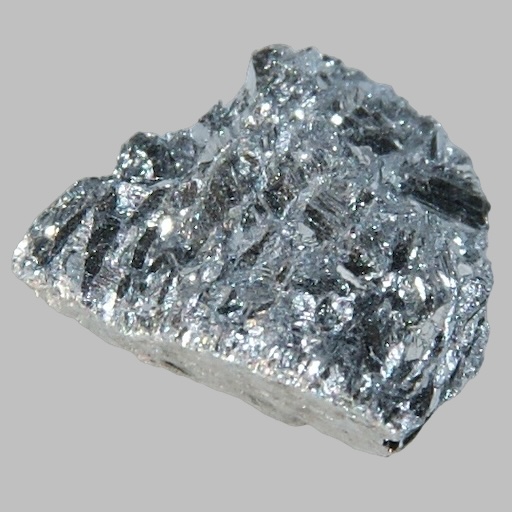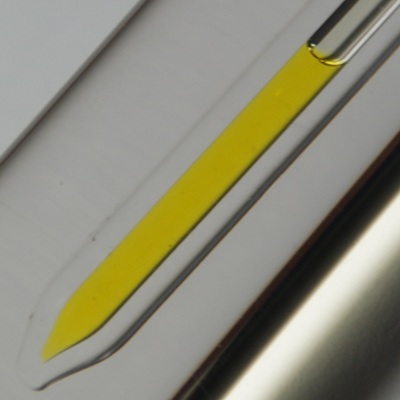Periodic Table Element Comparison: Compare Elements - Antimony vs Chlorine
Compare Antimony and Chlorine on the basis of their properties, attributes and periodic table facts. Compare elements on more than 90 properties. All the elements of similar categories show a lot of similarities and differences in their chemical, atomic, physical properties and uses. These similarities and dissimilarities should be known while we study periodic table elements. You can study the detailed comparison between Antimony vs Chlorine with most reliable information about their properties, attributes, facts, uses etc. You can compare Sb vs Cl on more than 90 properties like electronegativity , oxidation state, atomic shells, orbital structure, Electronaffinity, physical states, electrical conductivity and many more. Antimony and Chlorine comparison table on more than 90 properties.
Antimony and Chlorine Comparison
Facts
| Name | Antimony | Chlorine |
|---|---|---|
| Atomic Number | 51 | 17 |
| Atomic Symbol | Sb | Cl |
| Atomic Weight | 121.76 | 35.453 |
| Phase at STP | Solid | Gas |
| Color | Silver | Yellow |
| Metallic Classification | Metalloid | Halogens |
| Group in Periodic Table | group 15 | group 17 |
| Group Name | nitrogen family | fluorine family |
| Period in Periodic Table | period 5 | period 3 |
| Block in Periodic Table | p -block | p -block |
| Electronic Configuration | [Kr] 4d10 5s2 5p3 | [Ne] 3s2 3p5 |
| Electronic Shell Structure (Electrons per shell) | 2, 8, 18, 18, 5 | 2, 8, 7 |
| Melting Point | 903.78 K | 171.6 K |
| Boiling Point | 1860 K | 239.11 K |
| CAS Number | CAS7440-36-0 | CAS7782-50-5 |
| Neighborhood Elements | Neighborhood Elements of Antimony | Neighborhood Elements of Chlorine |
History
| Parameter | Antimony | Chlorine |
|---|---|---|
| History | The element Antimony was discovered by Arabic alchemist in year ca. 800 AD in one. Antimony derived its name from the Greek anti, 'against', and monos, 'alone' (stibium in Latin). | The element Chlorine was discovered by W. Scheele in year 1774 in Sweden. Chlorine derived its name from the Greek word chloros, meaning 'greenish yellow'. |
| Discovery | Arabic alchemist (ca. 800 AD) | W. Scheele (1774) |
| Isolated | () | W. Scheele (1774) |
Presence: Abundance in Nature and Around Us
Parts per billion (ppb) by weight / by atoms (1ppb =10^-7 %)
| Property | Antimony | Chlorine |
|---|---|---|
| Abundance in Universe | 0.4 / 0.004 | 1000 / 40 |
| Abundance in Sun | 1 / 0.01 | 8000 / 300 |
| Abundance in Meteorites | 120 / 20 | 380000 / 160000 |
| Abundance in Earth's Crust | 200 / 30 | 170000 / 100000 |
| Abundance in Oceans | 0.2 / 0.010 | 19870000 / 3470000 |
| Abundance in Humans | - / - | 1200000 / 210000 |
Crystal Structure and Atomic Structure
| Property | Antimony | Chlorine |
|---|---|---|
| Atomic Volume | 18.181 cm3/mol | 22.4129 cm3/mol |
| Atomic Radius | 133 pm | 79 pm |
| Covalent Radius | 138 pm | 99 pm |
| Van der Waals Radius | 206 pm | 175 pm |
Atomic Spectrum - Spectral Lines | ||
| Emission Spectrum |  |  |
| Absorption Spectrum |  |  |
| Lattice Constant | 430.7, 430.7, 1127.3 pm | 622.35, 445.61, 817.85 pm |
| Lattice Angle | π/2, π/2, 2 π/3 | π/2, π/2, π/2 |
| Space Group Name | R_ 3m | Cmca |
| Space Group Number | 166 | 64 |
| Crystal Structure | Simple Trigonal 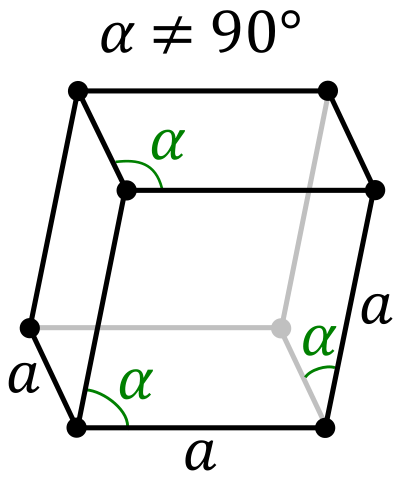 | Base Centered Orthorhombic 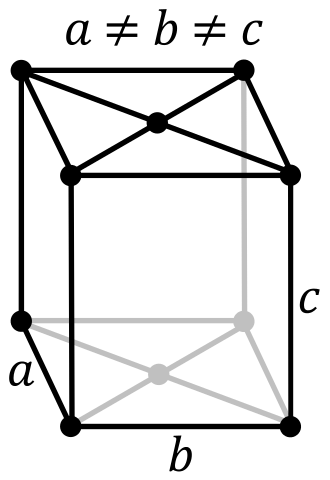 |
Atomic and Orbital Properties
| Property | Antimony | Chlorine |
|---|---|---|
| Atomic Number | 51 | 17 |
| Number of Electrons (with no charge) | 51 | 17 |
| Number of Protons | 51 | 17 |
| Mass Number | 121.76 | 35.453 |
| Number of Neutrons | 71 | 18 |
| Shell structure (Electrons per energy level) | 2, 8, 18, 18, 5 | 2, 8, 7 |
| Electron Configuration | [Kr] 4d10 5s2 5p3 | [Ne] 3s2 3p5 |
| Valence Electrons | 5s2 5p3 | 3s2 3p5 |
| Oxidation State | -3, 3, 5 | -1, 1, 3, 5, 7 |
| Atomic Term Symbol (Quantum Numbers) | 4S3/2 | 2P3/2 |
| Shell structure | 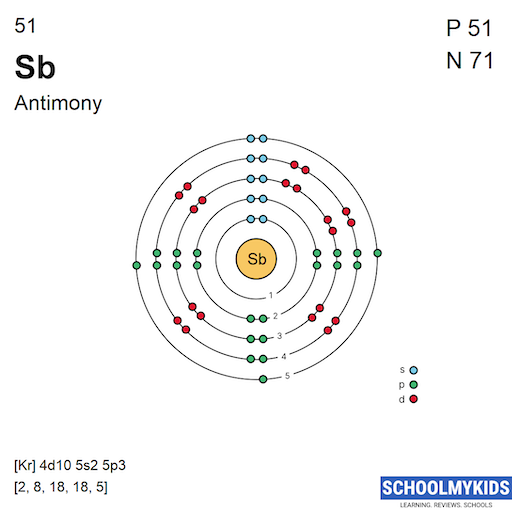 | 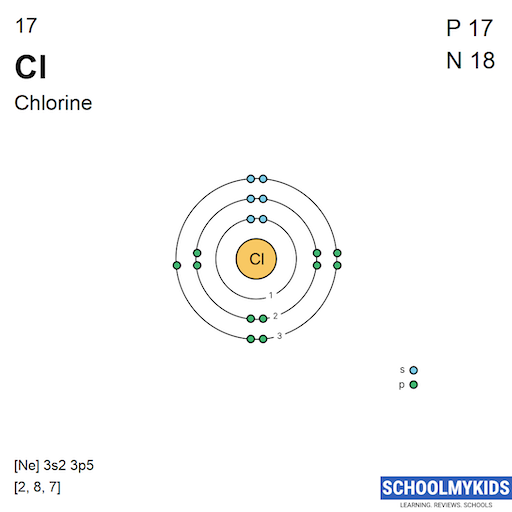 |
Isotopes and Nuclear Properties
Antimony has 2 stable naturally occuring isotopes while Chlorine has 2 stable naturally occuring isotopes.
| Parameter | Antimony | Chlorine |
|---|---|---|
| Known Isotopes | 103Sb, 104Sb, 105Sb, 106Sb, 107Sb, 108Sb, 109Sb, 110Sb, 111Sb, 112Sb, 113Sb, 114Sb, 115Sb, 116Sb, 117Sb, 118Sb, 119Sb, 120Sb, 121Sb, 122Sb, 123Sb, 124Sb, 125Sb, 126Sb, 127Sb, 128Sb, 129Sb, 130Sb, 131Sb, 132Sb, 133Sb, 134Sb, 135Sb, 136Sb, 137Sb, 138Sb, 139Sb | 28Cl, 29Cl, 30Cl, 31Cl, 32Cl, 33Cl, 34Cl, 35Cl, 36Cl, 37Cl, 38Cl, 39Cl, 40Cl, 41Cl, 42Cl, 43Cl, 44Cl, 45Cl, 46Cl, 47Cl, 48Cl, 49Cl, 50Cl, 51Cl |
| Stable Isotopes | Naturally occurring stable isotopes: 121Sb, 123Sb | Naturally occurring stable isotopes: 35Cl, 37Cl |
| Neutron Cross Section | 5.4 | 35.3 |
| Neutron Mass Absorption | 0.0016 | 0.033 |
Chemical Properties: Ionization Energies and electron affinity
| Property | Antimony | Chlorine |
|---|---|---|
| Valence or Valency | 5 | 5 |
| Electronegativity | 2.05 Pauling Scale | 3.16 Pauling Scale |
| Electron Affinity | 103.2 kJ/mol | 349 kJ/mol |
| Ionization Energies | 1st: 834 kJ/mol 2nd: 1594.9 kJ/mol 3rd: 2440 kJ/mol 4th: 4260 kJ/mol 5th: 5400 kJ/mol 6th: 10400 kJ/mol | 1st: 1251.2 kJ/mol 2nd: 2298 kJ/mol 3rd: 3822 kJ/mol 4th: 5158.6 kJ/mol 5th: 6542 kJ/mol 6th: 9362 kJ/mol 7th: 11018 kJ/mol 8th: 33604 kJ/mol 9th: 38600 kJ/mol 10th: 43961 kJ/mol 11th: 51068 kJ/mol 12th: 57119 kJ/mol 13th: 63363 kJ/mol 14th: 72341 kJ/mol 15th: 78095 kJ/mol 16th: 352994 kJ/mol 17th: 380760 kJ/mol |
Physical Properties
| Property | Antimony | Chlorine |
|---|---|---|
| Density | 6.697 g/cm3 | 0.003214 g/cm3 |
| Molar Volume | 18.181 cm3/mol | 22.4129 cm3/mol |
Elastic Properties | ||
| Young Modulus | 55 | - |
| Shear Modulus | 20 GPa | - |
| Bulk Modulus | 42 GPa | 1.1 GPa |
| Poisson Ratio | - | - |
Hardness - Tests to Measure of Hardness of Element | ||
| Mohs Hardness | 3 MPa | - |
| Vickers Hardness | - | - |
| Brinell Hardness | 294 MPa | - |
Electrical Properties | ||
| Electrical Conductivity | 2500000 S/m | 0.01 S/m |
| Resistivity | 4.17e-7 m Ω | 100 m Ω |
| Superconducting Point | - | - |
Heat and Conduction Properties | ||
| Thermal Conductivity | 24 W/(m K) | 0.0089 W/(m K) |
| Thermal Expansion | 0.000011 /K | - |
Magnetic Properties | ||
| Magnetic Type | Diamagnetic | Diamagnetic |
| Curie Point | - | - |
| Mass Magnetic Susceptibility | -1.09e-8 m3/kg | -7.2e-9 m3/kg |
| Molar Magnetic Susceptibility | -1.327e-9 m3/mol | -5.11e-10 m3/mol |
| Volume Magnetic Susceptibility | -0.000073 | -2.31e-8 |
Optical Properties | ||
| Refractive Index | - | 1.000773 |
Acoustic Properties | ||
| Speed of Sound | 3420 m/s | 206 m/s |
Thermal Properties - Enthalpies and thermodynamics
| Property | Antimony | Chlorine |
|---|---|---|
| Melting Point | 903.78 K | 171.6 K |
| Boiling Point | 1860 K | 239.11 K |
| Critical Temperature | - | 416.9 K |
| Superconducting Point | - | - |
Enthalpies | ||
| Heat of Fusion | 19.7 kJ/mol | 3.2 kJ/mol |
| Heat of Vaporization | 68 kJ/mol | 10.2 kJ/mol |
| Heat of Combustion | - | - |
Regulatory and Health - Health and Safety Parameters and Guidelines
| Parameter | Antimony | Chlorine |
|---|---|---|
| CAS Number | CAS7440-36-0 | CAS7782-50-5 |
| RTECS Number | {RTECSCC4025000} | RTECSFO2100000 |
| DOT Hazard Class | 6.1 | - |
| DOT Numbers | 2871 | 1017 |
| EU Number | - | - |
| NFPA Fire Rating | - | - |
| NFPA Health Rating | - | - |
| NFPA Reactivity Rating | - | - |
| NFPA Hazards | - | - |
| AutoIgnition Point | - | - |
| Flashpoint | - | - |
Compare With Other Elements
Compare Antimony and Chlorine with other elements of the periodic table.
